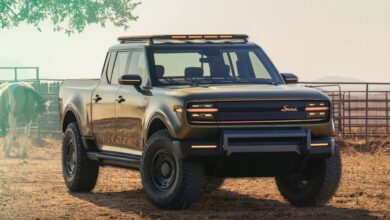Why Rivian Won’t Ever Use Dealers

- The direct-sales model used by companies like Tesla, Rivian and Lucid allows shoppers to buy cars at a fixed price, with no complicated haggling or shady add-ons.
- It’s a key advantage, allowing brands to control their own customer relationships, Rivian CEO RJ Scaringe says.
- That’s why Rivian is committed to the direct-sales model, even if it means foregoing some sales in the near term.
Buyers of Tesla, Rivian and Lucid EVs enjoy all sorts of things about their cars. Tesla makes the best software. Lucid builds the most efficient cars on the road. Rivian cranks out the best super-trucks that money can buy. But all three do one thing that customers love: They sell their products directly to consumers, rather than through dealers.
It’s one of their biggest advantages. And they’ll fight like hell to preserve it, as Rivian CEO RJ Scaringe explained in a roundtable interview with reporters in June.

The interior of one of Rivian’s “spaces,” which the company claims offer no-hassle, no-pressure opportunities to experience the product.
“We have the advantage of we’re direct only, and we’re unbendable there. We will forego sales to make sure we maintain a direct relationship with consumers,” Scaringe said. “And of course, there’s the margin part of that, which we’ve talked about before. But we also think it’s really important to be able to control the message, control how we talk to our customers, control every aspect of the service experience, control how we manage recalls. That puts the pressure on us.”
Traditional manufacturers outsource that work to dealers, which are independently owned and protected from automaker interference by strict franchise laws and contracts. That means a car company can’t stop dealers from pushing markups or shady add-ons, and it doesn’t have a direct hand in the service experience. That has some advantages—Chevrolet, for instance, can service ultra-remote corners of the country without General Motors having to invest its own resources there—but it makes it so that the dealer, not the manufacturer, is the main contact point for the customer.
If you’ve ever had to deal with a service issue for an EV, you may know why that’s a problem. If your Hyundai has an Integrated Charging Control Unit (ICCU) failure, for instance, the dealer needs to service it. But whether each dealer offers loaner cars is ultimately up to the luck of the draw. Hyundai corporate has no say in it. Still, the parts come from corporate, leading to a weird scenario: The dealer blames corporate, corporate blames the dealer, and the problem isn’t solved.
The frustration of this whole experience is laid out in a great video from Technology Connections. His point is clear: It’s not the actual defect that’s the problem, but Hyundai’s inability to communicate effectively about it. The company has no meaningful direct relationship with its customers, and its dealers are unreliable intermediaries.

Hyundai and Kia seem to struggle with this a lot, but I’ve seen it across the board. I’ve seen Ford dealers post big signs next to F-150 Lightnings saying “LOSES 30% RANGE IN COLD.” A Toyota salesman told me not to bother looking at the brand’s bZ4X. Toyota corporate is clear in its messaging, but the message that gets to consumers is anything but. This lends credence to Scaringe’s point that handling multi-channel communications through both dealers and corporate is “really tough.”
But taking on the responsibility is also a compromise. As Scaringe says, it puts pressure on Rivian to step up for customers. Sometimes, though, the company can’t. When it takes too long to service a broken R1T, there’s no one else to blame. Unfortunately, this has already happened plenty of times. There is no shortage of Rivian owners complaining online about long service times and difficult communication. Scaringe knows this better than most.
“We under-built service in a lot of our key markets,” he admits. “We’re catching up pretty quickly, but it’s nice that the accountability lies solely with us. It’s us saying ‘Oh, we didn’t invest in enough dealer or service capacity and footprint. Let’s go fix that.'”
That’s a pressing problem as the company prepares to launch the R2, its first mainstream SUV, with a target starting price of $45,000. Rivian expects the R2 to drastically increase its overall sales. That’ll be great for the company, but only if it can service them. And with a dead-last ranking in the last Consumer Reports reliability survey, Rivian may have some initial quality problems to work out, too. It needs to scale up its service network to meet that need.
“We call it building ahead. We have to build service infrastructure ahead of when the actual need is and also get the service locations themselves to be higher levels of efficiency,” Rivian’s CEO said. “So, technician utilization is a really big thing we track. Running service locations on multiple shifts is something we’re driving towards.”
It’s not clear whether Rivian’s service and sales network will be big enough to meet the needs of R2 customers. The company has about a year before R2 deliveries start, and we don’t know how quickly they will ramp up.
Scaringe projects confidence that the company will meet the moment. After all, despite the bad showing in reliability, Rivian owners remain some of the most satisfied in the industry. If the company can’t maintain that satisfaction as it scales up, it’ll have no one else to blame. Win, lose or draw, Rivian controls its own course.
Contact the author: Mack.Hogan@insideevs.com.
Source link

